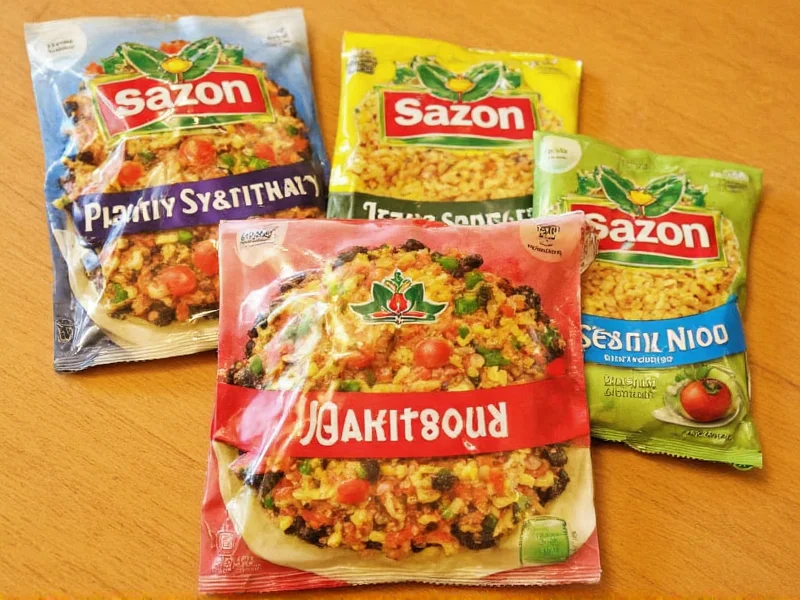Sazon seasoning packets offer home cooks a simple way to achieve authentic Latin American flavors. Each packet typically contains 0.7-1 ounce of seasoning blend designed to flavor one pound of meat or one cup of rice. The vibrant yellow-orange color comes primarily from annatto, which provides both hue and earthy flavor.
Understanding Sazon Seasoning Components
While formulations vary by brand, most sazon packets share these core ingredients:
| Primary Ingredient | Flavor Contribution | Function |
|---|---|---|
| Annatto (achiote) | Earthy, slightly peppery | Natural coloring agent |
| Cumin | Warm, nutty, slightly smoky | Base flavor component |
| Coriander | Citrusy, floral notes | Balances stronger spices |
| Garlic powder | Savory, pungent | Umami enhancement |
| Oregano | Herbal, slightly bitter | Traditional Latin accent |
Best Culinary Applications for Sazon Packets
Professional chefs and home cooks use sazon seasoning packets primarily for traditional Latin dishes where consistent flavor matters. The most effective applications include:
- Rice preparation - Add one packet per cup of uncooked rice for authentic achiote-colored rice
- Bean dishes - Enhances black beans, pigeon peas, and other legumes during cooking
- Protein seasoning - Rub directly on chicken, pork, or fish before grilling or roasting
- Stews and soups - Adds depth to caldos, sancocho, and other traditional broths
- Marinades - Combine with citrus juice and oil for quick meat preparations
Proper Usage Techniques
Many home cooks make mistakes when using sazon seasoning packets that diminish their effectiveness. For optimal results:
- Add sazon during cooking rather than at the end to allow flavors to meld
- Always combine with some fat (oil or butter) to properly release the annatto coloring
- Use one packet per pound of meat or cup of rice as standard measurement
- Avoid overusing - two packets can make dishes overly salty or bitter
- Store unused packets in cool, dark place to preserve flavor compounds
Brand Variations and Considerations
Different manufacturers offer sazon seasoning packets with distinct formulations. Goya remains the most widely available brand in North America, but regional variations exist:
- Goya Sazon - Contains MSG and salt as primary ingredients alongside spices
- Badia Sazon - Generally less salty with stronger garlic presence
- Regional formulations - Puerto Rican versions often include culantro, while Mexican versions may feature more cumin
- Salt-free options - Available for dietary restrictions but require additional seasoning
Creating Your Own Sazon Substitute
When commercial packets aren't available, you can create an effective sazon seasoning blend at home. The basic ratio for homemade sazon is:
- 2 tablespoons ground annatto (or paprika for milder color)
- 1 tablespoon ground cumin
- 1 tablespoon dried oregano
- 2 teaspoons garlic powder
- 1 teaspoon coriander
- 1 teaspoon salt (optional)
- ½ teaspoon black pepper
Mix these ingredients thoroughly and store in an airtight container. Use one tablespoon of this blend to replace one commercial sazon packet. For authentic color without annatto, substitute with 1 teaspoon turmeric plus 1 teaspoon sweet paprika.
Nutritional Profile Considerations
Most commercial sazon seasoning packets contain significant sodium content. A standard packet typically provides:
- Calories: 5-10 per packet
- Sodium: 200-300mg (8-13% of daily value)
- Carbohydrates: 1-2g
- Protein: less than 1g
For those monitoring sodium intake, look for reduced-sodium versions or create your own blend controlling the salt content. The annatto in sazon provides carotenoids with antioxidant properties, though in relatively small amounts per serving.
Storage and Shelf Life
To maintain maximum flavor and color potency:
- Store unopened packets in cool, dark pantry location
- Once opened, transfer unused portions to airtight container
- Properly stored sazon maintains quality for 12-18 months
- Discard if color fades significantly or aroma diminishes
Exposure to light, heat, or humidity accelerates flavor degradation in spice blends. For extended storage, keep sazon in the refrigerator in a moisture-proof container.
Traditional Dishes Featuring Sazon
Certain Latin American dishes rely on sazon seasoning for authentic flavor profiles:
- Arroz con Pollo - The yellow rice component requires sazon for proper color and flavor
- Pernil - Puerto Rican roasted pork benefits from sazon in the marinade
- Mofongo - Plantain dishes often include sazon in the mixture
- Asopao - Puerto Rican rice soup gains depth from sazon seasoning
- Feijoada - Brazilian black bean stew uses sazon variations for complexity
Chefs note that sazon works particularly well with ingredients common in Latin cuisine including plantains, yuca, and tropical fruits that balance the earthy spice notes.











 浙公网安备
33010002000092号
浙公网安备
33010002000092号 浙B2-20120091-4
浙B2-20120091-4